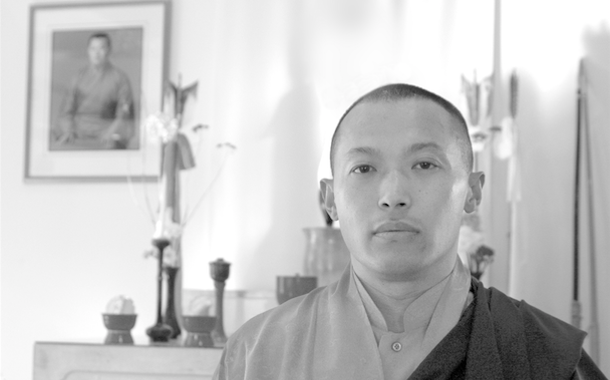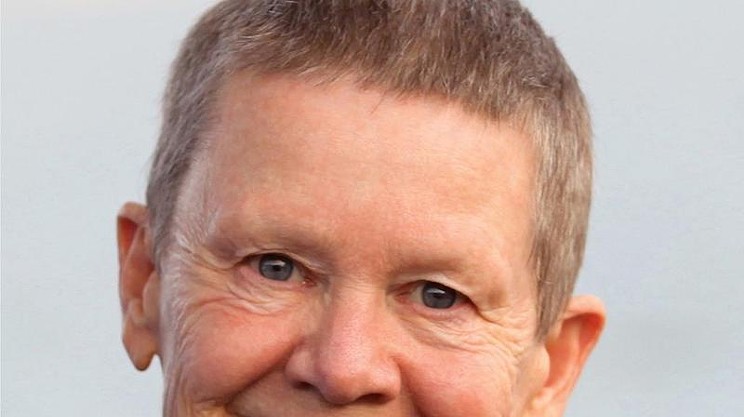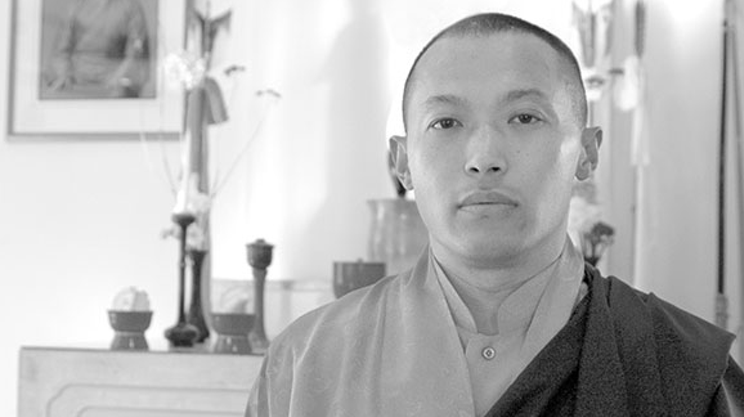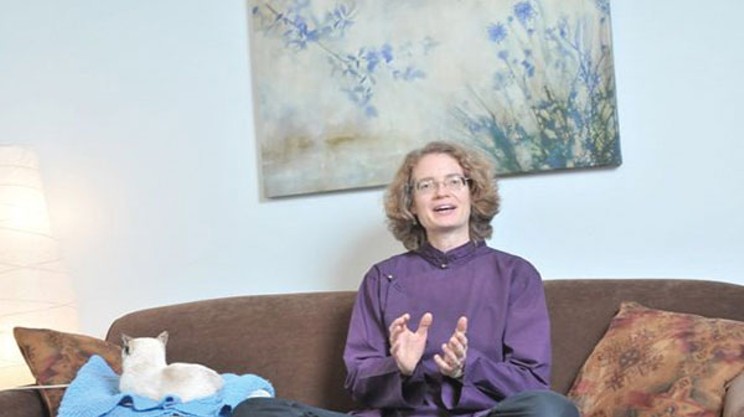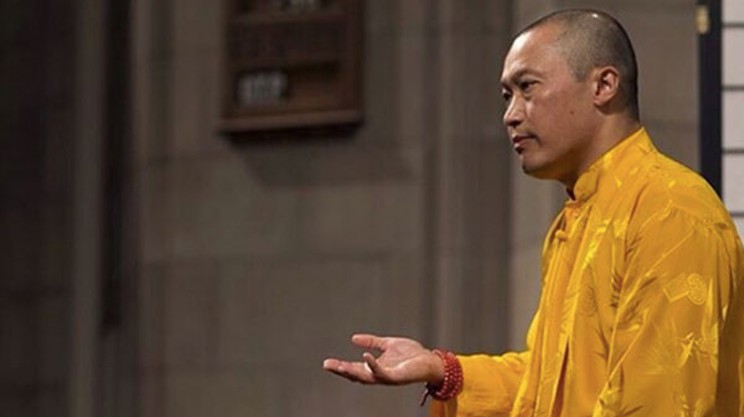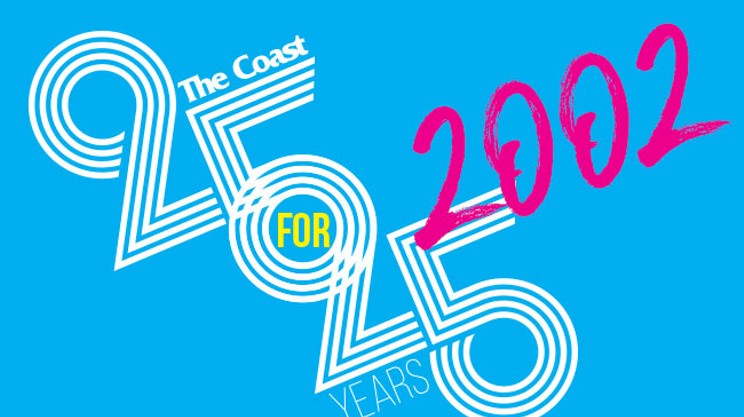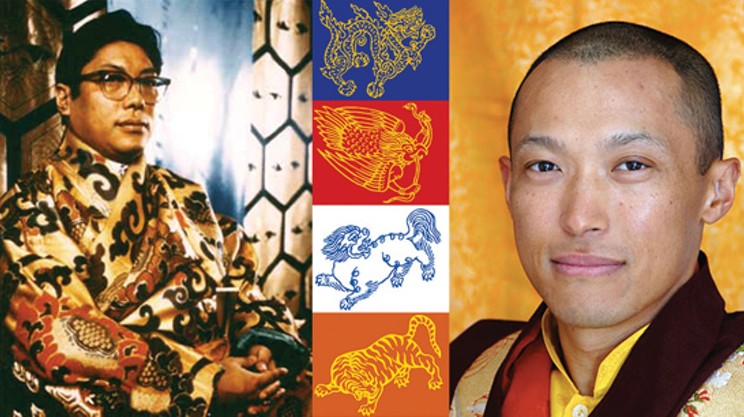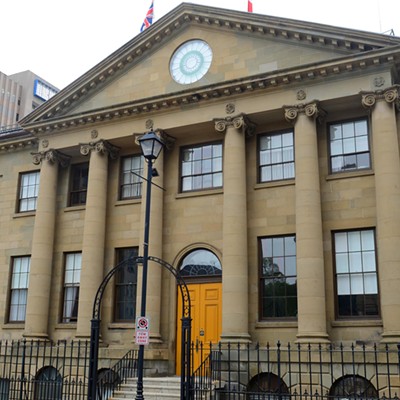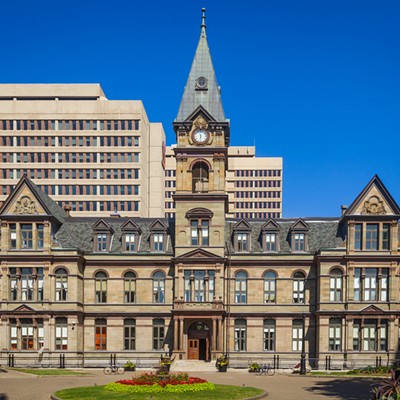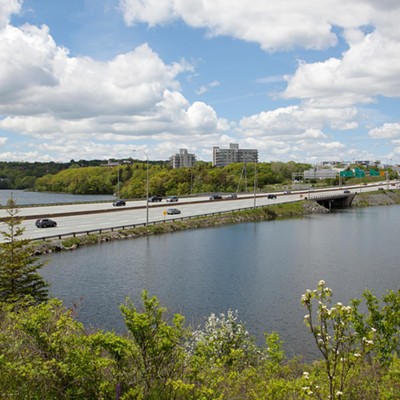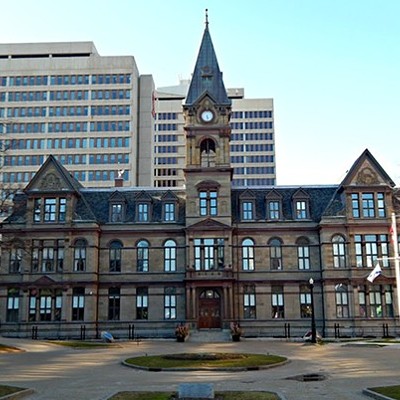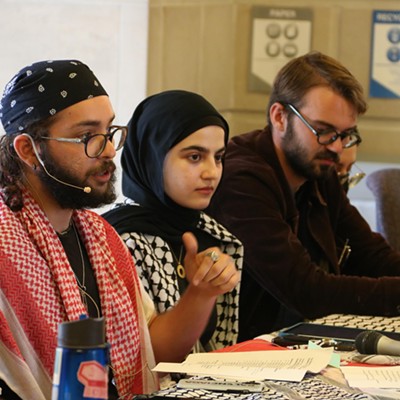Correction: This story originally stated the Shambhala School is owned by Shambhala International. While the two organizations share a name, they are not affiliated. The story has been updated to reflect this.
Rhonda Newcombe can’t look her guru in the eye. There are a couple reasons for that, chief among them the allegations against Sakyong Mipham Rinpoche of sexual abuse and assault.
The last time she was at the Halifax Shambhala Centre, for a community meeting, Newcombe found it unnerving to see all the books up on display, and to see his picture up on the wall. And though Newcombe has a student-teacher relationship with the sakyong, “there’s no going to him and saying, ‘This is how I feel about you,’ and getting some kind of feedback on that.”
On Monday, June 25, Mipham sent a letter to his community acknowledging that he had “engaged in relationships with women in the Shambhala community” and apologizing for “experiences of feeling harmed” some women had reported “as a result of these relationships.” Three days later, allegations were published that the sakyong had sexually assaulted two women and had an emotionally abusive sexual relationship with another. And nearly two weeks after those allegations—as detailed in a report from an initiative called Project Sunshine—the sakyong once more addressed his community in a letter.
Expressing “complete heartbreak,” “sorrow” and “accountability” for the pain Shambhalians were feeling, Mipham said he fully supports a third-party investigation of the allegations against him. He also said he would step back from his teaching and administrative roles in Shambhala International.
“I stood up in the Shambhala Centre,” Newcombe says, recalling that community meeting in July, “and said what I would ask him is: If these teachings are so absolutely precious, why would you do such things and think it would never come back?”
She shakes her head, incredulity on her face creasing into sorrow. “So, you know, I am absolutely heartbroken.”
Newcombe should brace for more heartbreak.
Both of the first two Buddhism Project Sunshine reports (the first, published February 15, included allegations of assault against teachers and community members) indicate evidence that the spiritual organization’s governing body knew about the allegations of harm by their leader and either did little to nothing to assist the people who said they’d been assaulted or, at worst, actively covered up and perhaps enabled the behaviour to continue.
Andrea Winn, who wrote those reports based on investigations by lawyer Carol Merchasin, says a third will be released on August 23. She predicts, with confidence, that its impact on the sakyong will be serious.
“He’s not going to be able to return to lead this community.”
***
The 55-year-old Mipham heads an international religious organization with more than 200 centres primarily in Canada, the United States, Europe and South America. In Halifax, the Shambhala Buddhist community (or sangha) comprised around 480 members at the time of this writing, though Shambhala Centre director Michelle Munro allows that may change in coming weeks.
“We have lost a small percentage of members. Any loss of members is challenging as a community and impactful to our financial stability. But it certainly is not daily. Or in droves.”
That financial stability is a very real concern. Members of the Halifax centre on Tower Road provide a monthly donation, and many serve as volunteers to help the centre carry out its work of offering drop-in meditation sessions, along with classes and retreats to
Shambhala International’s headquarters are here in Halifax and the sakyong maintains a residence—a mansion on the Northwest Arm called the Kalapa Court—at which he spends about a month per year. In addition to the Halifax Shambhala Centre, Nova Scotia is also home to two retreat centres—Gampo Abbey in Pleasant Bay, Cape Breton and Dorje Denma Ling, near Tatamagouche.
The Shambhala School in north end Halifax, meanwhile, shares a name with Shambhala, and emphasizes mindfulness practice, but is not affiliated with Shambhala International. It's a nondenominational independent school.
The sangha’s roots in this city go back to the late 1970s, when five families—all students of the sakyong’s father, Chogyam Trungpa Rinpoche—moved to Nova Scotia. Trungpa moved here himself from Boulder, Colorado in 1986, and many of his students followed.
Marguerite Drescher’s parents were among those trailblazers. They arrived in 1979, and she was born into Shambhala Buddhism two years later. Drescher owns Brave Space, which facilitates workshops and offers leadership training, among other services. She’s been thinking a lot about the sangha and her place in it—not just in the last few months, but for several decades.
“I am a member of the loyal resistance,” she offers, with a twist of a grin. “Shambhala is my community. It’s my home, my family. The birthright teachings and culture that I was offered have continued to be incredibly meaningful to me—but I have railed against the toxic structures in our
She was not surprised by the allegations in the first Project Sunshine report. Drescher says she knew of similar experiences. Still, there was an element of shock for her at how numbed she had become to those stories.
“How could I have not been more outraged?” she asks. “How did this get so normalized in me that I haven’t completely ditched, or been screaming my head off?”
In fact, Drescher has been screaming her head off. When she was 16, she and a group of seven or eight other girls wrote a letter to the local Shambhala Centre newspaper, calling out some men in their community for the way they objectified teenage girls.
“Creepy old man stuff,” she says. “They would make comments like, ‘Ooh, the beautiful dakinis.’ It was just this objectifying yuck. The weird hugs.”
And the women and men in her life seemed to dismiss all the behaviour as just the way things were.
“There was an air of, ‘Oh, it’s different here, in our spiritual bubble. It’s not the same as the world out there,’” she says. “I can’t say a particular person said it to me at a particular time, but it’s what I learned.”
Chogyam Trungpa Rinpoche was born in Tibet in 1939. He was the lineage holder of the Vajrayana school of Tibetan Buddhism and for the Shambhala teachings, which were mainly concerned with using mindfulness meditation to help create an enlightened society with a core belief in basic human goodness.“When you take a vow to a teacher and that teacher harms you and you have to continue to bow to that person, to supplicate, it’s so harmful.”
tweet this
Trungpa left Tibet in the uprising and fled with the Dalai Lama to India. He studied at Oxford, lived and taught meditation in Scotland for a time (where David Bowie was one of his students) and in 1970, then 31 years old, he married a wealthy 16-year-old and emigrated to America.
He was a controversial guru, who smoked, drank and had sex with his students. Trungpa coined the phrase “crazy wisdom” to describe some of the boundary pushing ways in which he sought to wake up his students. On one well-documented occasion at a Colorado retreat in 1975, he sent his guards—the Dorje Kasung—to break into the room of poet WS Merwin and his girlfriend Dana Naone and take them both, against their will, to a party where they were stripped naked while Naone begged for help.
In 1976, Trungpa empowered Thomas Rich as Vajra Regent, making him the next lineage holder of the Vajrayana teachings. The next year, he visited Nova Scotia for the first
Thomas Rich, the Vajra Regent, was a physical therapist from New Jersey. He met Trungpa in Colorado in 1971 and began studying with him. Trungpa would later write that Rich was his “prime student.”
Rich assumed leadership of Trungpa’s organization in 1987 and held it till his own death, of complications arising from HIV/AIDS, in 1990. Rich knew about his diagnosis for three
This was the Buddhist community Osel Mukpo inherited. Born in 1962, he’s said to be a reincarnation of Mipham the Great. The future sakyong spent the first seven years of his life in a refugee camp in India with his mother, a Buddhist nun, while his father studied at Oxford. He eventually joined Trungpa in Scotland when he was seven and followed his father to Colorado in 1972.
He was 25 when his father died, and 33 when he took his seat as Sakyong Mipham Rinpoche, holder of the Vajrayana lineage and the Shambhala teachings.
Marguerite Drescher remembers him as shy and awkward, growing up in Halifax. Though she’d heard stories of his “bad-boy behaviour” and knew people who had relationships with him, she always thought it wasn’t that bad.
“I did go to parties, we went out to Reflections after Shambhala events,” she says. “My girlfriend at the time and I danced with him at Reflections, and went back to the Court with lots of people, but I had no inkling that the kinds of things that were [alleged] in that report were happening.”
Others never saw that “bad-boy behaviour.” Julia Creighton hews to an old Buddhist teaching that students should “live three valleys away from their teacher.” Or, in this case, in Chester. She had no idea Mipham drank. The accusations against him left her shocked.
Creighton and her husband became students of Trungpa Rinpoche when he arrived in Nova Scotia in the ’80s. After he died, Creighton continued her studies with the sakyong.
Not everyone made that transition so easily. After Mipham took his seat and merged the Shambhala and Vajrayana teachings into Shambhala Buddhism, many in the sangha rebelled. Some longtime members saw a young man who was learning, sometimes faltering, to take his seat. It seemed Mipham had a disparate plan from his father’s vision. Some people weren’t willing to stick it out.
Creighton, though, studied with the sakyong and took Samaya with him. It’s the most advanced of a series of vows a Shambhala Buddhism student might take. It’s also complicated to explain, says Noel McLellan,
“It’s basically vowing to understand yourself as being in a very alive relationship with reality. I can’t escape from it so I’ll be with it, surrender to it, relate to it wholeheartedly.”
He acknowledges that’s a big bite to chew. So Shambhalians who take Samaya in fact “
For some students who spoke with The Coast, this means viewing their teacher as the Buddha—enlightened, moral, impeccable, even. And for many, that’s been hard to square with what this man is alleged to have done.
The first draft of the Buddhism Project Sunshine Phase One report was an admission of failure.“Shambhala isn’t the sakyong. He’s one senior teacher. Buddhism is very old. It’s not owned by him.”
tweet this
Andrea Winn, who’d grown up in a Buddhist family in California and Colorado, among other places, had spent a year trying to gather stories of sexual assault and abuse in Shambhala. Winn’s own experience, as she writes in the Phase One report, was one of childhood sexual abuse.
She alleges that most Shambhala children in her generation have been abused.
“A good friend of mine went to the 20-some people in my generation and there were only two of them that were not sexually abused,” she says. “And that generation includes Osel Mukpo, the current sakyong.”
Winn, now 50, doesn’t know if her friend asked the sakyong. She does know it’s been difficult for people in Shambhala to speak about what’s happened. When she first emailed everyone she could think of, explaining she was trying to gather stories, she didn’t receive a single one.
She was ready to call Project Sunshine a failure. She’d lived with her own secrets and demons for long enough, but it seemed that would be the end of things. But a posting in a Facebook group shook out a few stories. Then a few more. Anonymous accounts detailed an emotionally abusive marriage with a senior teacher; a sexual assault at the home of a woman who held a leadership position in the Halifax sangha, who would not reveal to the assaulted woman the name of her assailant; a genderqueer man who was assaulted by a sangha member on retreats; and many more.
In each case, the person at the heart of the story sought some help through their local Shambhala Centre or with teachers they knew. In each case, they felt unheard and unhelped.
Once the Phase One report came out in February, things started happening quickly. Winn was gratified people had come forward, and wasn’t surprised when more continued to find the strength to say what they had experienced.
“I knew there were stories,” she says. “There’s another woman in [Halifax] who for years had been doing the work of receiving women who’d been abused. So I knew it was widespread.”
Winn presented her Phase One report to the Kalapa Council, Shambhala International’s governing
That, she says, likely explains the timing of the sakyong’s first letter to the sangha on June 25. The Kalapa Council, meanwhile, announced on July 6 that its members would step down.
“The most important thing is for anyone who has been hurt or harmed to get the care that they deserve,” says Wendy Friedman, Halifax business owner and now former Kalapa Council member.“If he called upon you, you went, and you didn’t necessarily have the right to say no, which is all kinds of frightening that somebody would wield that power over people.”
tweet this
Friedman, who resigned alongside her colleagues earlier this month, did not agree to an interview but did provide a statement by email in which she writes that Shambhala’s practices, people and teachers have been the anchor and inspiration for most of her life.
“It seems pretty clear that we’re not immune to carelessness, mistakes and harm—so now is our moment of reckoning,” writes Friedman.
Much of the communication in this crisis has taken the form of written statements and public letters—authored by the sakyong, by the Kalapa Council, by senior teachers and directors at Shambhala Centres. Additionally, centres have held community meetings to give people a chance to talk about the allegations face-to-face. But so much more has been happening online.
If Andrea Winn lit the spark, social media fanned it into a roaring fire. On Twitter, on Reddit, in text messages and on Facebook, in public posts and private groups, the international sangha has been battling it out in a way that will be familiar to anyone who’s ever read the comments on any story about sexual assault in the age of #MeToo. Some defend their teacher. Others question the women. Many do both.
Some are struggling with Andrea Winn’s credibility and motivation. Others say she’s a liar who wants to dismantle Shambhala International.
Then there are those lauding her and the work she’s done—the current and former Shambhalians who’ve donated money to keep Project Sunshine going.
Some feel the framed photos of the sakyong should be covered up at the Shambhala Centre. Some centres elsewhere have already taken that step. There are those who believe Chogyam Trungpa Rinpoche’s photo should be covered too, for good measure.
Many who have left Shambhala over the years exchange harrowing stories of abuse at the hands of senior teachers, people in positions of authority, even Chogyam Trungpa Rinpoche himself—abuse they maintain was systematically denied, explained away or brushed under the rug.
Shambhala International declined an invitation to be interviewed for this piece, through the PR firm it hired. A request for an interview with Sakyong Mipham Rinpoche was also declined. The local Shambhala Centre would not speak specifically to questions about the Project Sunshine reports, though director Michelle Munro did agree to answer some questions by email.
This week, the outgoing Kalapa Council announced a transition team to oversee Shambhala International’s new governing board, and a process to “help improve future governance, leadership and representation.”
The transition task force includes Pema Chodron, who leads Gampo Abbey in Cape Breton, and Andrew Sacamano, a senior teacher born into Shambhala who grew up in Halifax. It’s facilitated by Basia Solarz, who works for the Nova Scotia Health Authority. Like so many parts of this story, the transition team is also causing a divide in the sangha.
“Some persons feel there are task force members who are complicit in the abuse and silencing the abuse,” says one local Shambhala member. “Many are very happy with the formation of the task force and the people on it.”
At the time of this writing, no formal complaints have been lodged with Halifax Regional Police about Mipham, but Shambhala International has hired Wickwire Holm, a business law firm in Halifax, which will investigate the Project Sunshine allegations and any others that can be collected between now and October.
Shambhala International has also engaged An Olive Branch, which provides “services to organizations in conflict after a beloved teacher has been accused of misconduct.”
Friedman says everyone, not just those within Shambhala, needs to look honestly at the issues of patriarchy, privilege, race and gender power if things are to change.
“I hope that the Shambhala sangha can find our way to a transparent, brave community that includes the beauty of the teachings and culture that I, and many of my friends, love and value,” she says. “It will never be perfect, but messy is real, and I’m good with real.”
Whatever any individual Shambhalian’s view on what has happened, and what should happen next, this is a community rocked to its core by these allegations—some because they’d had no idea and others because they’re finally coming to light.
Laura Burke is in that latter camp. She’s been “pulling away” from Shambhala for about four years, ever since a friend confided in her that “something” had happened to her at the hands of the sakyong after his daughter’s first birthday party in 2011.
Burke knows more of those details now, contained as they are in the second Project Sunshine report. She runs a hand through her short hair in exasperation, thinking about what she’s read.
“This revelation is putting words to something I’ve been feeling inside for many years,” she says. “It’s been empowering to watch my friend come forward with her story. It was heartbreaking to watch her struggle. When you take a vow to a teacher, and that teacher harms you and you have to continue to bow to that person, to supplicate, it’s so harmful.”
Burke found Shambhala in her late teens. It was a balm to her Catholic
These days, the comfort and liberation Burke once found in Shambhala teachings have turned to something darker. Her attempts to understand her friend’s experience have been unsatisfying.
“I went to what I thought would be safe places,” she says, “like a teacher who knew enough of the details of my friend’s situation that she should have pursued an inquiry. And she just said, ‘I’m sure he didn’t mean it.’”
When she first crossed the threshold of the Halifax Shambhala Centre 15 years ago, Rhonda Newcombe was a single parent of three whose parenting style “wasn’t working out for me,” she says.
“I found that by going to these meditation courses, meditation was helping me as a parent to take what comes, and not be so reactionary.”
That training has been
“I’m seeing a lot of heartbreak in the community, a lot of confusion. In some instances this is ironic, this is part of our teachings, to deal with having no ground—that all just dropped out from under me, how do I deal with that?” Newcombe says on a hot summer day at a downtown coffee shop. “Well, just be with it. So being with that is actually very, very raw. And that’s what I’ve been hearing from people.”
India Gailey says she wasn’t surprised to hear there were allegations of assault among some teachers and community members. The 25-year-old, child of parents who were students of Trungpa Rinpoche and who accepted his son as the new sakyong, is part of a new generation calling out sexual violence in society at large.
It’s understandable it would occur in Shambhala. But still, it’s heartbreaking to have it confirmed.
“The conflict around all of this. Everything exploding around it,” she says. “No one knows what’s going to happen and that’s scary. This thing people have devoted their whole lives to is crumbling apart.”
The schism created when Sakyong Mipham Rinpoche took his seat still festers in Halifax, where divisions sprang up within families and between friends. Many still speak of the pain of that schism as fresh and heartbreaking. On top of that schism comes a new one: How should Shambhala move forward after everything that’s come to light? And, maybe more impossible to consider, can it do so without a sakyong?“I would rather not have the profound transformative teachings of Buddhism, than to have the risk of that kind of harm and sexual violence.”
tweet this
He’s the core to many of Shambhala’s practices, and a guru to many students. Still, says Rhonda Newcombe, she’s not sure the sakyong should “take leadership again.” She considers it.
“That’s a hard pill to swallow and I don’t say that lightly at all. But how do you sexually assault people and then turn around a year or two later and say, ‘All better! You should look at me as fine now.’ Other people would say separate the teachings and the teacher, but I can’t.”
At the heart of Shambhala Buddhism is a belief that no one is irredeemable—where there’s life, there’s hope. Many Shambhalians talk about the sakyong with love. That’s how he signs his letters to them, as well. This love is close to the surface for Julia Creighton. Though she’s never had one-on-one time with the sakyong, her eyes well up when she considers the pain he’s likely in.
“He’s human,” she says, “and I will not turn my back on anyone, him or the women. There’s value in every human being.”
Laura Burke is able to find compassion for Mipham as well—to a point.
“There’s always been an immense amount of pressure on the sakyong. He’s had a weird bubble of a life, but I don’t think that means he shouldn’t have been accountable the whole time for these things.”
Though the Kalapa Council has stepped down, questions remain about their role in what seems like a cover-up of a pattern of behaviour.
That resonates with Newcombe. “There are people caring for him. Did nobody go, ‘Stop, you have to stop, you’re hurting someone.’ Or say to him, ‘Rinpoche, you’re going to be very mad at me, and I’m OK with that.’”
Still, Newcombe acknowledges how difficult it is to say that to a guru, let alone to the lineage holder of two strains of Tibetan Buddhism and the Shambhala teachings.
“Some people feel you can’t say no to the teacher, and for some women who had ‘relationships’”—she draws quotation marks in the air—
“Shambhala isn’t the sakyong,” says Burke. “He’s one senior teacher. Buddhism is very old. It’s not owned by him.”
While new teachings, or “terma,” would come to the sangha through the sakyong alone, Burke points out that there are plenty of teachings to contemplate already, and if there are going to be new teachings, maybe they could come from a teacher with a social justice lens.
For Marguerite Drescher, change is already afoot. She’s been volunteering with Shambhala’s office of social engagement, and she’s seeing a grassroots swelling of care and support.
“It’s really inspiring to see, as the centre implodes, the edges have some surround.” She gestures in a wide ring in front of her chest. “It is really open. It’s not about trying to get people to stay or convince them of anything, just holding space for whatever is coming up.”
Whatever happens next, for some in the sangha, the allegations against the sakyong and senior teachers has been a lightning rod for their own role in the community—and what it could be going forward.
“I honestly feel more engaged than ever,” says India Gailey. “I want to be part of the conversation and help figure things out even though I have no answers.”
Shambhala might rise again like a phoenix, but its rebirth will have to happen without the many souls who came to the sangha looking to find peace and instead found torment.
“I care more about people, the safety and dignity of people’s bodies and space and lives,” says Drescher. “I would rather not have the profound transformative teachings of
Ultimately, the answer may lie within each Shambhalian, says Noel McLellan.
“My understanding of what the sakyong is about, essentially from his teachings, is that everyone is a sakyong—an Earth protector, someone who cares about the whole Earth and holds up the essential goodness of everyone. So Sakyong Mipham Rinpoche officially has the title but in a
It’s a view Andrea Winn shares. In the Phase Two report of Project Sunshine, she proposes that all Shambhala students should consider themselves lineage holders, responsible for bringing teachings forward.
It’s clearly not gonna happen with the sakyong, she says. Right now, the sangha is in a transition state, believing Mipham will go to rehab and come back healed in a year or two. When the third Project Sunshine report is released later this month, Winn believes a return to Shambhala will no longer be an option.
“The information in that will make it clear that he can never come back,” she says. “So that leaves one option. For this to go forward, we’ll have to figure out another way that is without a sakyong.”
Stephanie Domet is a writer in Halifax.

